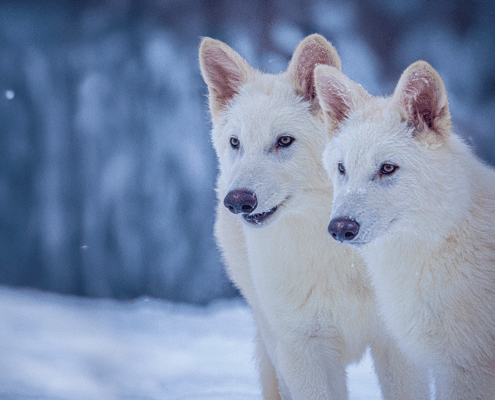
Colossal Biosciences Dire wolf pups, age three months.
IUCN Species Survival Commission
Canid Specialist Group
Taxonomic Review Task Force 18th April 2025
Conservation perspectives on gene editing in wild canids
Commentary on the announced re-creation of a genetic proxy of an extinct dire wolf by Colossal
On April 7, 2025 Colossal Biosciences Inc, a private biotechnology company established in Texas in 2021, announced they had re-created an extinct species, the dire wolf (Aenocyon dirus), in a process known as de-extinction.
The IUCN SSC Canid Specialist Group (CSG) is the world’s chief body of scientific and practical expertise on the status and conservation of all extant canid species. The CSG acknowledges the significant scientific breakthrough of the isolation of endothelial progenitor cells from a grey wolf (Canis lupus) and subsequent gene editing to create a genetically modified animal considered by Colossal to represent the extinct dire wolf. It should be noted that the dire wolf and the grey wolf are genetically distinct by thousands of genes while the gene editing by Colossal was done on only a handful of genes of the grey wolf genome to re-create phenotypic traits of a dire wolf. The questions of whether such genetically engineered organisms are adequate proxies of their extinct targets, as well as the potential role of this technological advancement in conservation of extant threatened species must be assessed carefully. However, neither question must divert attention from the core priority of species conservation, i.e., protecting remaining populations of threatened species in functioning ecosystems.
Globally, the main threats to species survival, including many wild species of Canidae, stem from habitat loss and degradation, human-wildlife conflict, invasive species, disease, and the overall disruption of natural processes.
Addressing these threats by securing viable habitats and supporting existing wild populations is essential to halting the biodiversity crisis.
Most species conservation efforts are limited by funding and access to relevant technology. Therefore, partnerships with companies that transparently contribute resources to conservation goals can be valuable, even if driven by commercial interests. There is an appetite for such partnerships to help support insufficient government and philanthropic funding for conservation.
Gene editing technologies may offer specific benefits to species survival, such as removing harmful mutations or increasing genetic diversity in small, inbred populations, and even potentially reviving ancestral variation lost in living populations today.
However, presenting this technology as a ready-to-use conservation solution is premature, and risks diverting attention from the more urgent needs of ensuring functioning and healthy ecosystems.
Creating three grey wolf pups with edited genomes in an attempt to resemble the extinct dire wolf may demonstrate technical capabilities, but it does not contribute to conservation. The dire wolf went extinct in the Americas some 12,000 years ago, and its ecological context—including prey species such as mammoths and giant ground sloths—is no longer present. Today, the grey wolf, which is adapted to current ecosystems, occupies that niche with a much-altered range of prey species. Editing the genome of a grey wolf to produce individuals that resemble an extinct species that has no ecological niche and that will not restore ecosystem function, does not follow the guiding principles on creating proxies of extinct species for conservation benefits put in place by the IUCN SSC. Indeed, creating phenotypic proxies of the dire wolf does not alter its conservation status, and may threaten the conservation status of extant species, like the grey wolf in the USA.
The three animals produced by Colossal are not dire wolves. Nor are they proxies of the dire wolf based on IUCN SSC guiding principles of extinct species for conservation benefit. First, there is no evidence that the genetically modified animals are phenotypically distinct from the grey wolf and phenotypically resemble the dire wolf. Second, our knowledge of the behaviour, phenotype, and ecology is inherently limited because the dire wolf is extinct.
Rapid advances in gene editing could contribute to future conservation efforts as a useful addition to our conservation toolbox, but they should not be adopted as a panacea to the current biodiversity crisis. Suggesting that extinction can be reversed through technology risks undermining the urgency of conserving existing species and ecosystems. Relying on the notion that we can “restore” lost species through gene editing diverts attention from the most critical conservation goal: protecting the biodiversity and habitats that currently sustain life on Earth.
Our focus at the CSG continues to be the protection of extant canid species in their wild habitats and to seek to reverse the drivers that ultimately determine their fate.
Statement prepared by the CSG Taxonomic Review Task Force
Andrew Kitchener, Ben Sacks, Claudio Sillero, Daniel Chavez, Fabio Machado, Geraldine Werhahn, Helen Senn, Jorgelina Marino, Kylie Cairns, Lauren Hennelly, Mike Hoffmann, Suvi Viranta

